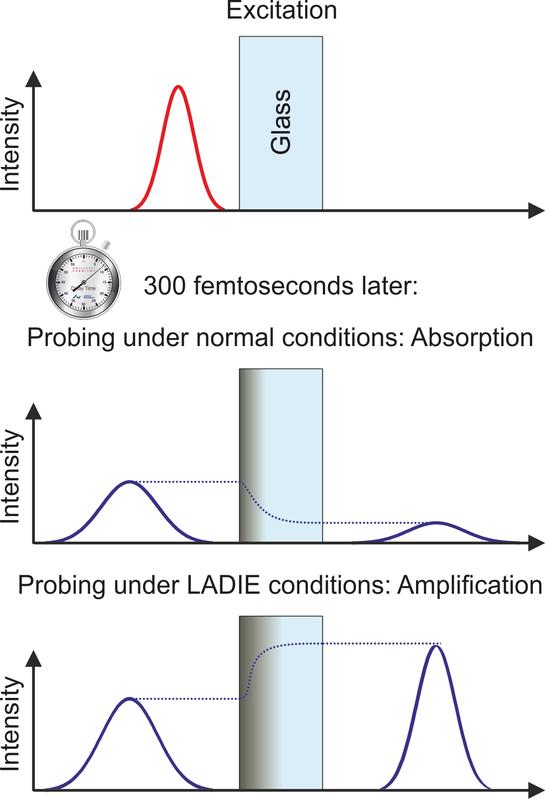
Coherent Amplification in Laser-Excited Dielectrics Explained

Copyright: Uni Kassel
If a transparent dielectric material like water or glass is illuminated by visible or infrared light it is transmitted without loss. This quickly changes if ultra-short laser pulses on the femtosecond timescale (quadrillionth second) are used:
Caused by the high intensities that such laser pulses provide, different interaction mechanisms are able to transfer the transparent material into a metallic like state. The created “free” electrons, similar to a metal, play a significant role in the change of the optical properties associated to the excitation of the material.
Accordingly, pump-probe experiments, utilizing two temporally delayed laser pulses were proven to be a very useful method to investigate the laser-material interaction. Indeed, most experiments show that shortly after the laser excitation, absorption and reflection increase due to the creation of high density of free electrons giving the dielectric material transient metallic properties.
Researchers from the Experimental Physics III located at the University of Kassel, in cooperation with colleagues from the Department of Physics at the University of Aarhus in Denmark, recently performed similar experiments on laser excited sapphire glass.
Much to their surprise, the researchers observed that the absorption of a violet probe pulse is, under certain conditions, replaced by coherent amplification. The physicists could link the observed amplification to the, so far, unobserved LADIE mechanism. While in typical light amplification processes, such as a laser, single photons are doubled, the study suggests that the LADIE process provides a multi photon process, for example making four out of two incident photons.
“It is too early to foresee possible impacts or applications of the LADIE effect”, says Thomas Winkler, scientist at the Kassel Department of Physics. “Yet it provides a more detailed understanding of the light material interaction. However, also the discovery of the LASER in the mid 60s by Theodore Maiman was an unusual discovery that was initially seen as no more than another thrilling aspect of quantum physics. However, today, more than 50 years later, there are no products or technical process in which laser-technology is not involved in a certain way.”
The publication was published on Monday, 18th September 2017 and is available under the following link: https://www.nature.com/nphys/journal/vaop/ncurrent/full/nphys4265.html
For a picture (copyright: Uni Kassel), please see: https://www.uni-kassel.de/uni/fileadmin/datas/uni/presse/anhaenge/2017/NatPhysic…
Contact:
Thomas Winkler
Universität Kassel
Institut für Physik
Tel.: +49 561 804 4319
E-Mail: winkler@physik.uni-kassel.de
Prof. Dr. Thomas Baumert
Universität Kassel
Institut für Physik
Tel: +49 561 804 4452
E-Mail: baumert@physik.uni-kassel.de












